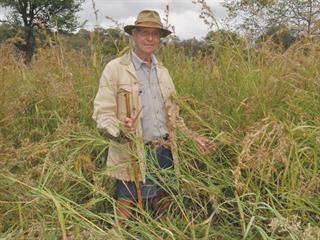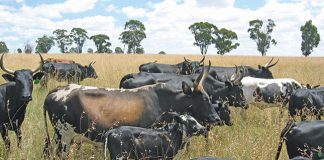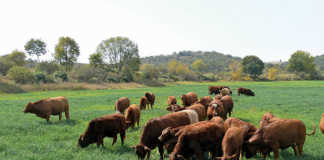
Does the idea of running twice the number of livestock on your land for significantly more profit while improving your veld and grazing appeal to you? There’s no livestock farmer in the world who’d say “No”.
Enter Allan Savory. Over 50 years, he has proved that this and more is achievable on holistically managed farms worldwide. Yet when he shares his management process with farmers there’s always a “But …”
“Most don’t prosper because they don’t want to change,” says Allan. “They’ll endlessly discuss the merits of their particular cattle breed, but try to address the most important aspect of farming, yield per hectare, and you lose them. They say ‘But we’ve farmed this way for generations’ or ‘But what if it doesn’t work for me’.
“I’ve proved Holistic Management works throughout the world. Yet, 600 000 US farming families went bankrupt in the 1970s and 1980s because they refused to change. This when an Ohio State University study had recorded an average of 300% more profit with Holistic Management.”
For his ability to think and act outside the mainstream, Allan and his Operation Hope initiative in Zimbabwe were selected from over 250 projects worldwide as the winner of the coveted 2010 Buckminster Fuller Challenge.
Operation Hope
Operation Hope is run on the 2 630ha Dimbangombe Ranch near Victoria falls, Zimbabwe, with an annual but erratic rainfall of 600mm. It has shown how increasing livestock numbers by 400% and using holistic grazing planning, veld degradation can be reversed, dead soil can become thriving grassland and dry watercourses can flow again.
It proves livestock farming can be environmentally sustainable and profitable at the same time, and help turn around the desertification of vast areas – one of the primary causes of climate change.
This perfectly reflects the ethos of the Buckminster Fuller Challenge, which recognises initiatives that radically advance human wellbeing and the health of our planet’s ecosystems.
What Allan is doing is working with nature, starting with the soil. “Trying to manage livestock without managing the soil is like trying to manage oxygen and hydrogen separately in water,” he explains.
“Land, livestock, farmers’ culture and their economy form one indivisible whole, ultimately revolving around soil. That’s why I’m calling for a Brown Revolution instead of a Green Revolution.” He emphasises that what he’s saying is nothing new. “The theory of holism as life’s operating principle was first presented by South African statesman Jan Christian Smuts in 1926.”
Outperform their best breeds
“I‘m so convinced of the holistic approach that I challenge farmers to give me the worst cattle in the country and I guarantee I’ll outperform their best breeds,” says Allan.
One of the first shifts required for holistic farming is to rethink the concept of stocking rates. “First, if farmers are serious about profit, they must understand that higher yields of meat per hectare come from higher stocking rates more so than from animal performance. This also lowers the overhead cost per animal.
“Second, as John Acocks pointed out in the 1960s, South Africa is understocked and overgrazed. The veld degradation, which is serious all over the country, is due to too few animals overgrazing the vegetation, combined with the soil being over-rested, and the use of fire.”
Allan explains that only two management tools can rehabilitate the vast seasonal rainfall grasslands and savannas in South Africa and elsewhere – grazing and animal impact, or the physical impact of large herbivores (mainly livestock).
“Contrary to conventional agricultural thinking, large numbers of livestock are needed for healthy veld and grasslands. I battled to come to terms with this concept because it defies deep-rooted agricultural concepts such as official stocking ratios.”
A former wildlife conservationist in Zimbabwe, Allan says he too once blamed overgrazing for desertification.
“I was prepared to shoot every bloody rancher in the country,” he recalls. “I’d accepted as fact the myth permeating range/veld science – that overgrazing is due to too many animals. Thousands of PhD dissertations have assumed this, without producing any evidence.”
But following research on the defoliation of grasses and its effects on root sacrifice, French researcher Andre Voisin found that overgrazing was a function of how long a plant was exposed to grazing, combined with how long it was before being grazed again. “In other words, overgrazing is a function of time and not of animal numbers,” explains Allan.
“Whether there’s one cow or 1 000 doesn’t alter the fact of overgrazing, it just changes the number of plants overgrazed if the animals remain too long in the same place or return too soon.
“Few people heard what Voisin was saying when he produced this research 50 years ago, but it struck a chord with me, and started changing my thinking.
“My earliest breakthrough observation was noting the greater health of land where animal numbers were highest. Given Voisin and Acocks’s work, I began to work out how to regenerate veld using more animals while minimising overgrazing, using a high graze/trample:recovery ratio.”
Managing with herders
Dimbangombe Ranch’s 500 cattle and some goats graze intensively as one large, undivided herd from dawn to sunset. Fulltime herders herd from the front to control the pace at which the animals move. The herd is never spread, operating as a concentrated unit occupying less than 1ha at any time and moving constantly.
The holistically planned grazing process ensures that no area is grazed or trampled for more than three days and the herd does not return to it for three to nine months, irrespective of the season. When Allan initiated holistic planned grazing eight years ago “the veld here was so bad the best soil had been 90% bare for over 30 years, due to continuous grazing and frequent burning.”
Burning leaves the land and soil exposed and vulnerable, destroying desirable species and encouraging less desirable species, and contributing to progressive desertification. Holistic Management also eliminates most of the reasons why farmers burn.
The ranch’s previous owner couldn’t run more than 100 cattle on the same 2 360ha. Today, Operation Hope could easily double its 500-head herd. It battles to keep up with the grass production, even in dry years.
There are no fences at Dimbangombe, which doubles as a wildlife ranch with abundant elephant, buffalo and other big game. Allan prefers herding to fenced camps to keep the herd concentrated. As he points out, it’s the hoof impact that stimulates more grass to grow. Being on the ground at all times, the herdsmen can best decide where to lead the animals – as opposed to conventional scattering of cattle in camps according to some rotational or other grazing system.
But Allan says the same “fast-moving” planned grazing process can also be practised in fenced camps, provided there are enough camps per herd run on the farm. “Enough” has no precise definition, he explains, but it would be at least 30 camps per herd.
“Generally, the size of the herd is more important than that of the camps. More cattle are needed for the trampling which increases grass growth,” says Allan. The number and size of camps and whether to use camps or herdsmen must be determined to suit each farm and farmer’s Holistic Management financial planning and goal.
Animal Impact: the most important tool
The most important Holistic Management ‘tool’ is high animal impact on the land for short periods interspersed with much longer periods of rest for plant and soil life recovery.
“Ecological thinking has advanced considerably and recognises that seasonal rainfall grasslands need periodic disturbance for overall health,” explains Allan.
“Universities in Texas and Arizona designed machines to simulate the physical effects of vast herbivore herds, like the millions of bison that once roamed North America or South Africa’s millions of springbok.”
Allan realised that livestock hooves, mouths and digestive systems could perform this same task in a managed way, at little cost, while making a profit without consuming fossil fuel. Large herbivores:
- Break soil crusts – as anyone who has tracked animals knows. The effect is more pronounced in large herds. The broken crust lets soil absorb water and breathe, so plants can germinate and establish.
- Compact the soil under their hooves, required for good seed-to-soil contact to increase germination, just as farmers put a heavy roller over certain crops after planting.
Dunging recycles grass plant material to the soil surface faster. The rapid decay keeps the life cycle going uninterrupted. Without this, gradual oxidation and the physical weathering of dead grass takes over and grasslands tend to shift to desert scrub and bare soil in low rainfall areas, or to woody plants in higher rainfall areas.
Allan stresses that timing is crucial. For example, trampling for too long powders soil, increasing erosion by wind and water. It also compacts in the deeper soil layers, which is bad for plant growth.
Concentrated livestock herds
Operation Hope’s herders use their concentrated livestock herd to either break soil surfaces, compact soil to ensure seed germination or recycle dead plant material biologically and rapidly. They crowd the herd onto any land “needing gardening” to increase plant establishment. They look for bare soil and ensure the surface is broken up and litter and dung are laid down by a short period of soil compaction.
The concentrated herd effect also protects the livestock from lions, leopards, hyaenas, wild dogs and cheetahs that roam free on the same land. The livestock are also herded into portable “woven stick mat” kraals for the night. “The kraals provide extremely high animal impact and we use them for no more than seven consecutive nights to heal any seriously eroding gullies or extremely compacted bare soil,” Allan explains.
The dramatic reversal of desertification on these sites has been monitored by fixed-point photography over several years.
Allan advises those starting to farm holistically to take the official stocking rate for the farm and double it. “Start your holistic grazing planning straightaway and build from here,” he says. “Take fixed-point photos each season. You’ll be amazed at the veld’s recovery and by how many animals you can run on your farm after a few years.”
Winning over the sceptics
Holistic management is not for the mentally lazy. “You have to be prepared to spend time planning,” says Allan. “Farmers sometimes don’t take to it, or start and then give up because two to three hours planning a year is too much effort.
“In Zimbabwe we had many projects in the 1970s, but when I was forced into exile in 1979 for criticising government all the farmers abandoned Holistic Management.”
American rangeland scientist Keith Raether and ecologist Joy Belsky criticised the projects as failures. “The projects did fail but not because of Holistic Management – the farmers gave up,” says Allan. “I’ve yet to see a farmer who stuck with the planning fail, even through a run of dry years.”
Allan has battled to win over authorities and academics, but he recently drew up a memo of understanding with a team of top scientists from South Africa’s Agricultural Research Council. They’re planning extensive documentation in six watersheds in Zimbabwe of land under holistic planned grazing.
Much of this engagement has come about because of the Buckminster Fuller prize. “It’s breaking the ice with extension officers and academics worldwide who have condemned my approach all these years,” Allan says. “Finally we’re all talking.
“We need millions of cattle to rehabilitate the world’s veld/rangelands. At the same time we’ll be producing healthy red meat.
“Humans are omnivores and we need to eat healthy meat raised in a healthy way on healthy land. It’s a win-win all round. Farmers will prosper, and livestock will restore ecosystems. Instead of ‘eat less meat’, lobbyists will say ‘eat more holistically raised meat to help save the planet’.”
E-mail Allan Savory at [email protected] or contact Jozua Lambrechts, South African Holistic Management educator, on 083 310 1940, or e-mail [email protected]. Visit www.savoryinstitute.com.













